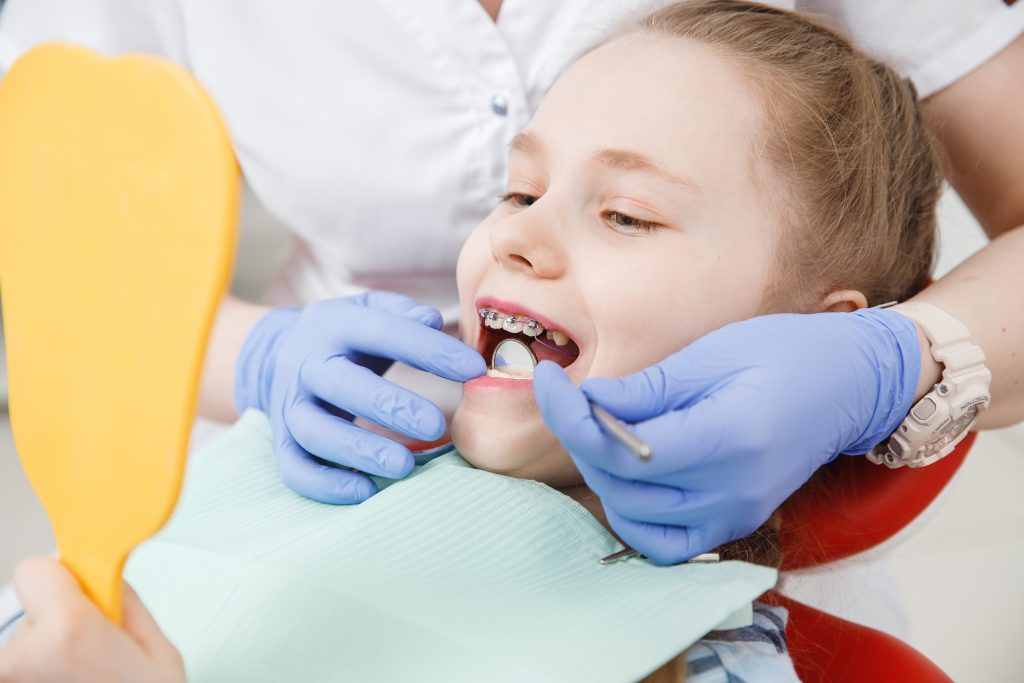As a parent, you might be wondering if it’s time for your little one to get braces. It’s a big step, but don’t worry – you’re not alone! Millions of kids wear braces each year, paving the way for healthier, more confident smiles.

Young preteen girl in glasses wearing braces smiles at the camera on a summer day.
From crooked teeth to misaligned jaws, orthodontic care can address a variety of dental issues. But when’s the right time to start? What can you expect? And how do you prepare your child for this new adventure?
In this comprehensive guide, we’ll walk you through everything you need to know about braces for kids. So, let’s get ready to embark on the path to your child’s perfect smile!
Why Do Kids Need Braces?
Orthodontics for kids is more than just achieving a picture-perfect smile. While aesthetics are important, the primary goal is to address various orthodontic problems that can affect a child’s oral health and overall well-being. Here are some common issues:
- Crooked teeth or misaligned teeth
- Crowded teeth or overcrowding
- Overbites or underbites
- Jaw misalignment affecting jaw growth
- Difficulty chewing or speaking
Braces help correct these dental issues, improving both oral health and appearance. They’re not just about looks – they can prevent future dental problems too!
When Should Kids Get Braces?
There’s no one-size-fits-all answer to this question. The best age for braces depends on each child’s specific needs. However, here are some general guidelines:
- Most kids get braces between nine and 14 years old
- Some might start earlier if they have severe issues
- Your pediatric dentist or orthodontist will recommend the right age for treatment
Remember, early intervention can often mean shorter treatment time. It’s best to get an orthodontic evaluation by age seven, when children still have some of their baby teeth but are also getting their adult teeth.
Types of Braces for Kids
There are several types of braces available. Let’s look at the most common ones:
- Traditional metal braces – the most common type
- Ceramic braces – less visible than metal braces
- Lingual braces – hidden behind the teeth
- Clear aligners (like Invisalign Teen)
Your orthodontist will help you choose the best option for your child. Each type has its pros and cons, so consider factors like braces cost, visibility, and maintenance.
The Initial Consultation
The first step in your child’s orthodontic treatment is the initial consultation. Here’s what to expect:
- A thorough examination of your child’s teeth and jaw
- X-rays and possibly 3D scans
- Discussion about different types of treatment options
- Explanation of costs and insurance coverage
- Answering any questions you or your child might have
Don’t be shy – ask all the questions you need to feel comfortable about the treatment plan!
Preparing for Braces
Once you’ve decided to go ahead with braces, it’s time to prepare. Here are some tips:
- Schedule the appointment for a time when your child won’t miss school
- Stock up on soft foods for the first few days
- Buy a water flosser and special orthodontic toothbrush
- Discuss pain management options with your orthodontist
- Prepare your child mentally by explaining the process
A little preparation can go a long way in making the transition smoother.

Girl at reception with dentist, conduct an examination of braces and state of enamel from caries.
Getting the Braces On
The big day has arrived! Here’s what typically happens when braces are put on:
- Teeth cleaning and polishing
- Application of a special adhesive
- Attaching brackets to each tooth
- Placing the archwire and securing it with elastic bands
The whole process usually takes 1-2 hours. It’s not painful, but your child might feel some pressure.
The First Few Days with Braces
The initial days with braces can be challenging. Your child might experience:
- Soreness in teeth and gums
- Difficulty eating
- Speech changes
- Irritation inside the mouth
These issues are normal and temporary. Encourage your child to be patient – it gets better!
Eating with Braces
Your child’s diet will need some adjustments with braces. Here’s a quick guide:
Foods to avoid:
- Hard candies
- Popcorn
- Nuts
- Chewy or sticky foods
Foods that are safe:
- Soft fruits
- Cooked vegetables
- Dairy products
- Pasta and rice
Remind your child to cut food into small pieces and chew carefully.
Oral Hygiene with Braces
Good oral hygiene is crucial with braces to prevent tooth decay. Here’s a basic routine:
- Brush after every meal
- Use a water flosser or orthodontic flosser daily
- Rinse with mouthwash
- Use wax on brackets if they cause irritation
Make it fun by letting your child choose their toothbrush color or flavored toothpaste!
Regular Check-ups and Adjustments
Your child will need regular dental visits to the orthodontist. These appointments are for:
- Tightening or adjusting the braces
- Checking progress
- Addressing any issues or concerns
These visits are usually every 4-8 weeks. Don’t skip them – they’re essential for successful treatment!
Long-term Benefits of Braces
Braces do more than just straighten teeth. They can:
- Improve overall oral health
- Boost self-confidence
- Prevent future dental issues
- Enhance facial structure
The benefits last a lifetime, making the temporary discomfort worthwhile.
Supporting Your Child Through the Process
Getting braces can be tough on kids. Here’s how you can support them:
- Be patient and understanding
- Celebrate milestones in their treatment
- Help them stay positive
- Remind them of the end goal
Your encouragement can make a big difference in their experience.
Final Thoughts
Braces for kids are a big commitment, but they’re worth it. With proper preparation and care, your child can sail through the process and end up with a beautiful, healthy smile. Remember, every step of the way, from the initial consultation to the final retainer check, is bringing your child closer to their dream smile.
The American Association of Orthodontists recommends early orthodontic evaluations, so don’t hesitate to start this journey at a young age if needed. Stay positive, be supportive, and before you know it, you’ll be admiring your child’s straight, radiant teeth!
















Add Your Comment